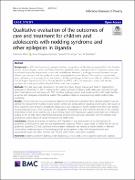| dc.contributor.author | Abbo, Catherine | |
| dc.contributor.author | Mwaka, Amos Deogratius | |
| dc.contributor.author | Opar, Toliva Bernard | |
| dc.contributor.author | Idro, Richard | |
| dc.date.accessioned | 2021-04-28T15:29:33Z | |
| dc.date.available | 2021-04-28T15:29:33Z | |
| dc.date.issued | 2019-04-30 | |
| dc.identifier.citation | Abbo, C., Mwaka, A.D., Opar, B.T. and Idro, R., 2019. Qualitative evaluation of the outcomes of care and treatment for children and adolescents with nodding syndrome and other epilepsies in Uganda. Infectious diseases of poverty, 8(1), pp.1-12. | en_US |
| dc.identifier.issn | 2049-9957 | |
| dc.identifier.uri | http://hdl.handle.net/20.500.12280/2781 | |
| dc.description.abstract | Background: In 2012, the Ugandan Government declared an epidemic of Nodding Syndrome (NS) in the Northern districts of Gulu, Kitgum, Lamwo and Pader. Treatment guidelines were developed and NS treatment centres were established to provide symptomatic control and rehabilitation. However, a wide gap remained between the pre defined care standards and the quality of routine care provided to those affected. This study is to qualitatively assess adherence to accepted clinical care standards for NS; identify gaps in the care of affected children and offer Clinical Support Supervision (CSS) to Primary Health Care (PHC) staff at the treatment centres; and identify psychosocial challenges faced by affected children and their caregivers.
Methods: This case study was carried out in the districts of Gulu, Kitgum, Lamwo and Pader in Uganda from September to December in 2015. Employing the 5-stage approach of Clinical Audit, data were collected through direct observations and interviews with PHC providers working in public and private-not-for-profit health facilities, as well as with caregivers and political leaders. The qualitative data was analysed using Seidel model of data processing.
Results: Clinical Audit and CSS revealed poor adherence to treatment guidelines. Many affected children had suboptimal NS management resulting in poor seizure control and complications including severe burns. Root causes of these outcomes were frequent antiepileptic drugs stock outs, migration of health workers from their work stations and psychosocial issues. There was hardly any specialized multidisciplinary team (MDT) to provide for the complex rehabilitation needs of the patients and a task shifting model with inadequate support supervision was employed, leading to loss of skills learnt. Reported psychosocial and psychosexual issues associated with NS included early pregnancies, public display of sexual behaviours and child abuse.
Conclusions: Despite involvement of relevant MDT members in the development of multidisciplinary NS guidelines, multidisciplinary care was not implemented in practice. There is urgent need to review the NS clinical guidelines. Quarterly CSS and consistent anticonvulsant medication are needed at health facilities in affected communities. Implementation of the existing policies and programs to deal with the psychosocial and psychosexual issues that affect children with NS and other chronic conditions is needed | en_US |
| dc.language.iso | en | en_US |
| dc.publisher | BioMed Central Ltd | en_US |
| dc.relation.ispartofseries | Infectious diseases of poverty;8(1) | |
| dc.subject | Nodding syndrome | en_US |
| dc.subject | Epilepsy | en_US |
| dc.subject | Multi-disciplinary | en_US |
| dc.subject | Clinical audit | en_US |
| dc.subject | Clinical support supervision | en_US |
| dc.subject | Uganda | en_US |
| dc.title | Qualitative Evaluation of the Outcomes of Care and Treatment for Children and Adolescents With Nodding Syndrome and Other Epilepsies in Uganda | en_US |
| dc.type | Article | en_US |


